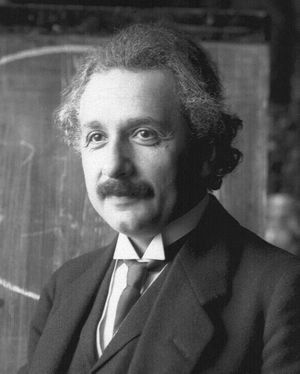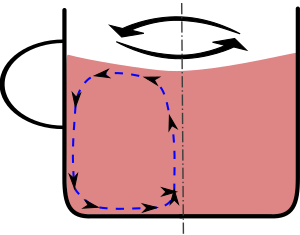مفارقة ورقة الشاي
 ألبرت إينشتاين حل المفارقة في 1926. |
مفارقة ورقة الشاي tea leaf paradox، تصف ظاهرة تحرك أوراق الشاي في كوب الشاي إلى وسط وقاع الكوب بعد التقليب بدلا من تجمعها على الحواف، كما هو مفترض أن يحدث عن طريق قوة الطرد المركزي. أول من قام بحل هذه المفارقة ألبرت أينشتاين في ورقة بحثية قدمها عام 1926 حيث فسر فيها ظاهرة تآكل ضفاف الأنهار (Baer's law).[1][2][3]
. . . . . . . . . . . . . . . . . . . . . . . . . . . . . . . . . . . . . . . . . . . . . . . . . . . . . . . . . . . . . . . . . . . . . . . . . . . . . . . . . . . . . . . . . . . . . . . . . . . . . . . . . . . . . . . . . . . . . . . . . . . . . . . . . . . . . . . . . . . . . . . . . . . . . . . . . . . . . . . . . . . . . . . .
التفسير
Stirring the liquid makes it spin around the cup, causing a centrifugal force outward. با However, near the bottom and outer edges the liquid is slowed by the friction against the cup. هناك قوة ضرد مركزي أضعف ويصبح اختلاف الضغط أكثر أهمية لتدفق السائل. This is called a boundary layer or more specifically an Ekman layer.[4]
Because of the centrifugal force, the pressure is higher along the rim than in the middle. If all the liquid rotated as a solid body, the inward (centripetal) force would match the outward (centrifugal) force from the rotation and there would be no inward or outward movement.
In a teacup, where the rotation is slower at the bottom, the pressure gradient takes over and creates an inward flow along the bottom. Higher up, the liquid flows outward instead. This secondary flow travels inward along the bottom bringing the leaves to the center, then up, out and down near the rim. The leaves are too heavy to lift upwards, so they stay in the middle. Combined with the primary rotational flow, the leaves will spiral inward along the bottom.[1][3]
التطبيقات
استخدمت هذه الظاهرة لتطوير التقنية الجديدة لفصل خلايا الدم الحمراءعن بلازما الدم[5][6] to understand atmospheric pressure systems,[7] and in the process of brewing beer to separate out coagulated trub in the whirlpool.[8]
انظر أيضا
المصادر
- ^ أ ب Wollard, Kathy (October 13, 2008). "How Come?: Loose tea leaves gather in a cup's center". Newsday. Retrieved 2008-12-28.
- ^ Bowker, Kent A. (1988). "Albert Einstein and Meandering Rivers". Earth Science History. 1 (1). Retrieved 2008-12-28.
- ^ أ ب Einstein, Albert (March 1926). "Die Ursache der Mäanderbildung der Flußläufe und des sogenannten Baerschen Gesetzes". Die Naturwissenschaften. Berlin / Heidelberg: Springer. 14: 223–4. doi:10.1007/BF01510300. English translation: The Cause of the Formation of Meanders in the Courses of Rivers and of the So-Called Baer’s Law, accessed 2008-12-28.
- ^ "CEE 262A Hydrodynamics Lecture 18" (PPT). 2007. p. 35. Retrieved 2008-12-29.
- ^ Arifin, Dian R. (20 December 2006). "Microfluidic blood plasma separation via bulk electrohydrodynamic flows". Biomicrofluidics. American Institute of Physics. 1 (1): 014103 (CID). doi:10.1063/1.2409629. PMC 2709949. PMID 19693352. Retrieved 2008-12-28.
{{cite journal}}: Unknown parameter|coauthors=ignored (|author=suggested) (help); Unknown parameter|laydate=ignored (help); Unknown parameter|laysource=ignored (help); Unknown parameter|laysummary=ignored (help) - ^ Pincock, Stephen (17 January 2007). "Einstein's tea-leaves inspire new gadget". ABC Online. Retrieved 2008-12-28.
- ^ Tandon, Amit. "Einstein's Tea Leaves and Pressure Systems in the Atmosphere" (PDF). Retrieved 2008-12-29.
{{cite web}}: Unknown parameter|coauthors=ignored (|author=suggested) (help) - ^ Bamforth, Charles W. (2003). Beer: tap into the art and science of brewing (2nd ed.). Oxford University Press. p. 56. ISBN 9780195154795.
قراءات إضافية
- Highfield, Roger (14 January 2008). "Dr Roger's Home Experiments". The Daily Telegraph. Retrieved 2008-12-28.
وصلات خارجية
- Sethi, Ricky J. (September 30, 1997). "Why do particles move towards the center of the cup instead of outer rim?". MadSci Network. Retrieved 2008-12-29.
- Booker, John R. "Student Notes - Physics of Fluids - ESS 514/414" (PDF). Department of Earth and Space Sciences, University of Washington. ch. 5.8 p. 48. Retrieved 2008-12-29. See also figure 25 in figures.pdf
- Stubley, Gordon D. (May 31, 2001). "Mysteries of Engineering Fluid Mechanics" (PDF). Mechanical Engineering Department, University of Waterloo. Retrieved 2008-12-29.

